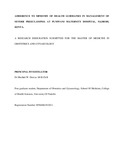| dc.contributor.author | Muchiri, Dorcus W | |
| dc.date.accessioned | 2015-09-03T06:32:47Z | |
| dc.date.available | 2015-09-03T06:32:47Z | |
| dc.date.issued | 2015 | |
| dc.identifier.uri | http://hdl.handle.net/11295/90372 | |
| dc.description.abstract | Background
Preeclampsia and eclampsia are important reproductive health concerns being the second cause
of maternal morbidity and mortality in Kenya. For this reason, the Ministry of Health in Kenya
developed and implemented guidelines in order to prevent adverse outcomes and to standardise
the care across all health care workers who manage women with these conditions.
Despite these efforts, the mortality and morbidity related to preeclampsia and eclampsia has not
changed. This brings to question whether the guidelines are understood and utilised in
accordance with the stipulation.
Objective
To determine the level of adherence to Kenya Ministry of Health guidelines in management of
severe preeclampsia and eclampsia at Pumwani Maternity Hospital.
Design
This was a cross sectional study in which records of patients managed for severe pre eclampsia
and eclampsia at Pumwani maternity hospital between 2010 and 2013 were reviewed.
Methodology and Setting
A retrospective analysis of recorded information was done using a template from the Ministry Of
Health, Kenya guidelines on the management of severe pre eclampsia and eclampsia. The study
site was Pumwani Maternity Hospital, Nairobi. A sample size of 262 was calculated for this
study. The data was collected electronically by the principal investigator and trained research
assistants using a data abstraction tool that had been created from existing MOH guidelines.
SPSS statistical package version 21 was used to analyse the data based on the specific objectives.
Ethical consideration
Permission to carry out this research was sought from the Kenyatta National Hospital
(KNH)/UON ethics and research committee and Pumwani Maternity Hospital.
Results
A total of 263 records were analysed. These were presented in tables and diagrams. The overall
adherence to guidelines was 31.4%. History taking and examination was at 67.8%, investigations
13.9%, fetomaternal monitoring 26.1%, use of recommended guidelines 29.5% and post partum
interventions 20%.
Conclusions
The study showed a situation of clinical practice in discordance with the prescribed standards.
The adherence to guidelines was poor leading to poor assessment of patients.
Recommendations
There is overall need for regular clinical audits at the facility, dissemination of appropriate
knowledge on management of severe preeclampsia and eclampsia, improvement of
documentation and provision of appropriate medications if these are not available. | en_US |
| dc.language.iso | en | en_US |
| dc.publisher | University of Nairobi | en_US |
| dc.title | Adherence to ministry of health guidelines in management of severe preeclampsia at Pumwani maternity Hospital, Nairobi, Kenya. | en_US |
| dc.type | Thesis | en_US |
| dc.description.department | a
Department of Psychiatry, University of Nairobi, ; bDepartment of Mental Health, School of Medicine,
Moi University, Eldoret, Kenya | |
| dc.type.material | en_US | en_US |

